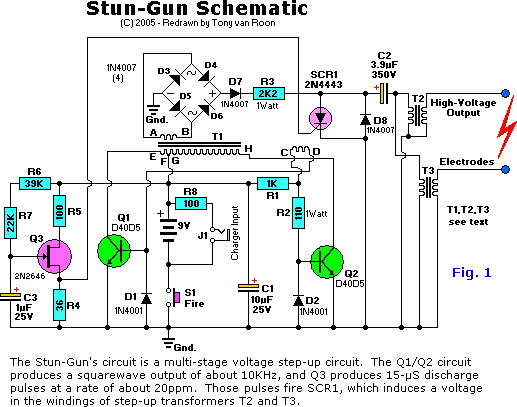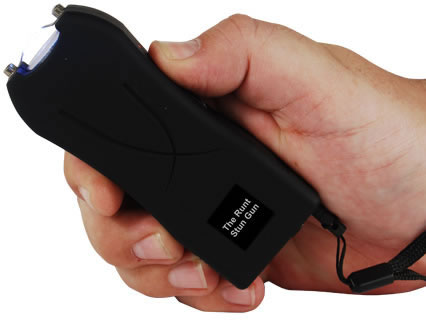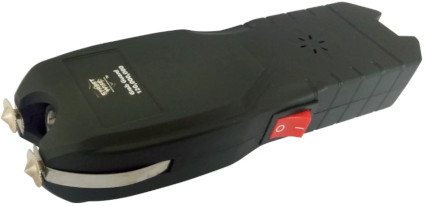Highest Amperage Stun Gun

When it comes to stun guns, most people assume higher voltage means more power—but that’s a common myth.
✦ Voltage determines how easily electricity can penetrate clothing.
✦ Amperage (measured in milliamps) is what actually incapacitates an attacker.
So, if you’re looking for the most powerful stun gun, you need to focus on amperage, not just voltage. In this guide, we’ll explain:
- Why amperage is more important than voltage
- How high-amperage stun guns work
- The legal limits on stun gun power
- The best high-amperage stun guns available today
Just want to Buy?
Powerful Self-Defense Stun Guns and TASER devices here at TBOTECH
The Truth About Stun Gun Voltage: Marketing Hype vs. Reality

Back in the early 2000s, stun guns were marketed by their voltage, starting with 300,000 volts. As manufacturers competed, the numbers skyrocketed into the millions—with some brands now claiming 100 million volts or more.
♦ Fact: A stun gun only needs 25,000 volts to penetrate clothing. Anything beyond that is mostly marketing hype rather than increased stopping power.
So, what really determines a stun gun’s effectiveness? Amperage.
Why Amps Are the Real Power Behind Stun Guns
The human body reacts to amperage, not just voltage. Even one amp can be lethal, which is why stun guns are designed to stay under 5 milliamps (mA) for safety.
| Stun Gun Power Levels | Effect on the Body |
|---|---|
| 1 milliamp (mA) | Tingling, mild discomfort |
| 3-4.9 mA | Pain, muscle contractions, temporary incapacitation |
| 5+ mA | Risk of device failure or circuit burnout |
♦ Most high-amperage stun guns operate between 3 and 4.9 milliamps, delivering enough discomfort and muscle disruption to stop an attacker without permanent harm.
How High-Amperage Stun Guns Work
Key Components of a Stun Gun:
1️⃣ Power Source: Rechargeable battery or replaceable battery pack
2️⃣ Transformer & Circuitry: Boosts electrical output to create high-voltage pulses
3️⃣ Metal Probes: Deliver the charge directly to an attacker
4️⃣ Capacitor: Stores and releases electrical energy in bursts
When activated, the stun gun overloads the attacker's nervous system, causing pain, muscle spasms, and temporary immobilization, allowing you to escape.
♦ Tip: The best areas to target are large muscle groups, such as:
✅ Upper body (chest, abdomen)
✅ Neck and shoulders
✅ Thighs or groin
Legal Limits on Stun Gun Amperage
While there are no universal laws on stun gun amperage, most manufacturers cap devices at around 5 milliamps. Anything higher could cause device failure or be classified as too dangerous for civilian use.
✦ TASER devices, used by law enforcement, typically operate at 1.2 to 2.1 milliamps, but they rely on longer exposure times to incapacitate suspects.
✦ Civilian stun guns often push the limit to 4.9 mA, making them more effective for quick, personal defense situations.
Check your local laws before purchasing a stun gun to ensure compliance.
Best High-Amperage Stun Guns for Maximum Stopping Power
If you want the strongest legal stun gun, look for models that maximize amperage while keeping voltage at a reasonable level.
1️⃣ The Runt Stun Gun (4.5 mA)
✅ Compact and easy to conceal
✅ High-powered 4.5 mA shock for maximum effect
✅ Rechargeable battery for long-term use
✅ Rubberized grip for firm handling
2️⃣ Grab Guard Anti-Grab Stun Gun (4.9 mA)
✅ Max legal amperage at 4.9 mA
✅ Heavy-duty design with metal prongs
✅ Anti-snatch plates deliver shock if grabbed
✅ Built-in LED flashlight
✦ View the Grab Guard 120,000,000 Stun Gun
3️⃣ The Master Blaster (4.9 mA)
✅ Disable Pin for added safety
✅ Bright flashlight function
✅ High-powered rechargeable battery
FAQs: Stun Gun Voltage & Amperage
Q: What is the highest legal amperage for a stun gun?
✅ Most civilian stun guns cap at 4.9 milliamps to remain safe and effective.
Q: How many volts is a typical stun gun?
✅ Voltage ranges from 25,000 to several million volts, but anything above 25,000V can already penetrate clothing.
Q: Are high-voltage stun guns better?
❌ No. High voltage doesn’t always mean more power—amperage is what stops an attacker.
Q: Can stun guns go through thick clothing?
✅ Yes, even basic 25,000V stun guns can penetrate jackets and jeans.
Q: Will a stun gun work on someone under the influence?
✅ Yes, but more prolonged contact may be required to incapacitate an attacker under the influence of drugs or alcohol.
Final Verdict: Is a High-Amperage Stun Gun Right for You?
✅ If you’re looking for the most effective non-lethal self-defense weapon, a high-amperage stun gun (4.5 to 4.9 mA) is your best option.
♦ Remember:
- Voltage isn’t everything—focus on amperage for true stopping power.
- Check your state’s stun gun laws before purchasing.
- Recharge your stun gun every 2-3 months for maximum reliability.
✦ Ready to buy? Browse our collection of high-amperage stun guns here.



